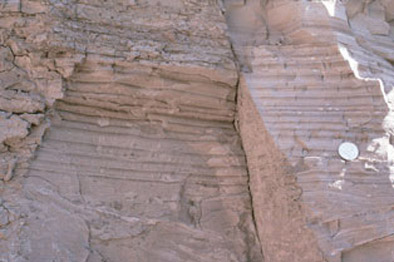 Other Methods of Absolute Dating
Other Methods of Absolute Dating
Just like you flip pages of a calendar to record the passing of a month, some natural processes produce records of geologic time. You have just learned about radiometric dating and how the decay of radioactive isotopes can be used to assign absolute dates to geologic materials. You will now learn about three other natural processes that are used to calculate absolute dates. Click each image below to learn more about these processes.

Tree rings record information about past climate as well as events such as insect infestations and forest fires. The study of tree rings to find the age of materials is called dendrochronology. It is best used in temperate climates, where trees grow in seasonal patterns and where growth rings are most visible. The thickness and texture of each annual growth ring records clues about the environment when that ring was formed, especially climatic conditions such as temperature and humidity. By comparing the pattern of rings from one tree to another tree, a chronology of a forested region can be produced. The patterns of annual growth rings can be matched from living to dead trees to form a record extending back several thousand years in some locations. However, they are most accurate and useful when only dating materials several hundred years old. This makes tree ring dating useful for assigning ages to young geologic events
Varve counting is another means of absolute dating. A thin sedimentary layer deposited over the time of one year is called a varve. If the rate of sedimentation for an area is known, then the age of sediment layers can be calculated by counting the number of varves in an area. Varves deposited by glaciers are called glacial varves and they are characterized by dark-colored bands of clay-sized sediment alternating with light-colored bands of sand-sized sediment. They can be used to date materials back about 20,000 years.

Ice sheets that develop in polar regions and on Earth’s highest mountains also record seasonal changes and the regular passing of time. Drill cores obtained from polar ice sheets show that these layers of ice can be counted to obtain a record of almost 65,000 years long. Not only are these layers useful for absolute dating, they also provide valuable climate data. They record the chemical composition of precipitation at the time when they were deposited, and give us clues about the values of different chemical elements in the atmosphere during the past. For example, they show widespread contamination of the air at the same time in history as the beginning of the Industrial Revolution.

Tree ring dating can be used to date materials made from wood from how many years ago?
Tree ring dating can be used to date materials several thousand years back, but is most accurate dating materials several hundred years back.

What segment of geologic time can be dated using ice layers?
Ice layers can be used to date time back about 65,000 years.
© KC Distance Learning. All rights reserved.
 Other Methods of Absolute Dating
Other Methods of Absolute Dating




